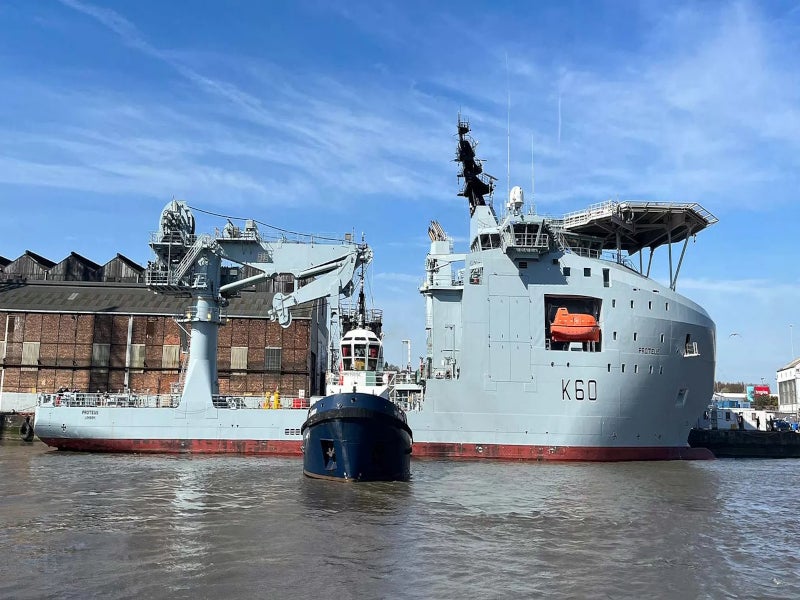RFA Proteus, previously known as Topaz Tangaroa, is a multirole ocean surveillance (MROS) vessel in operation with the Royal Fleet Auxiliary (RFA), a critical support arm of the UK Royal Navy. The vessel was built to enhance the UK’s maritime capabilities.
Functioning as a mothership for remotely operated vehicles (ROVs), it houses a range of specialised capabilities for monitoring and safeguarding the UK’s critical underwater infrastructure.
The UK Ministry of Defence’s procurement arm Defence Equipment and Support (DE&S) purchased RFA Proteus from Topaz Energy and Marine, a subsidiary of P&O Maritime Logistics, for £70m in January 2023.
The elevated risk posed by adversaries targeting key energy and communication cables on the seabed has prompted the UK government to expedite the acquisition of MROS vessels.
MROS programme details
RFA Proteus is the first of the two vessels developed as part of the MROS programme.
Topaz Tangaroa drydocked at the Cammell Laird shipyard in Merseyside, UK, in January 2023, where it underwent military conversion into RFA Proteus.
The vessel departed from Merseyside for trials and training near Portland in September 2023 and later proceeded to London to dock alongside the historic wartime cruiser HMS Belfast for dedication service.
The dedication ceremony for the vessel took place in October 2023, followed by the delivery to the Royal Navy in November 2023.
Another commercial vessel MV Island Crown arrived at HMNB Devonport for military conversion into the second MROS vessel RFA Stirling Castle in January 2023.
The state-of-the-art RFA Stirling Castle is poised to serve as a launchpad for autonomous minehunters, providing support for mine-hunting operations. White heat technology will be utilised in the vessel, using a series of uncrewed systems, to detect, identify, and eliminate potential mine threats. The vessel arrived in Devonport for trials and training in April 2023.
RFA Proteus design details
RFA Proteus is a new-generation survey and surveillance ship designed as an airship. It has a length of 98m, moulded width of 20m, and maximum scantling draft of 6m. Its adaptable displacement is 6,000 tonnes (t) and deadweight is 3,000t.
Equipped with remote and autonomous offboard systems, the vessel has a range of capabilities such as underwater surveillance and seabed warfare.
A crew comprising 26 RFA officers and sailors and 60 Royal Navy experts can be accommodated in the vessel.
The vessel features a flight deck and a 1,000m2 cargo deck, along with a robust crane designed for lifting and lowering operations. A moon pool, which is an expansive access point in the hull’s bottom, helps to launch robot submersibles.
Engine and performance
RFA Proteus employs a diesel-electric propulsion system, utilising azimuth thrusters at the stern. Five Caterpillar diesel generators power the vessel, allowing it to cruise at a maximum speed of 14 knots while the normal speed is 11 knots.
Contractors involved
Cammell Laird, a shipbuilding company based in the UK, was responsible for preparing the vessel for its new operations, including the installation of crane and deck machinery and other external upgrades.
RFA Proteus and RFA Stirling Castle are both part of Cammell Laird’s RFA cluster. Cammell Laird will provide support for the ships, both domestically and in operational regions worldwide.
MV Topaz Tangaroa details
Topaz Tangaroa was an offshore patrol vessel built by Vard, a shipbuilding company based in Norway, in 2019.
The vessel was designed to perform subsea operation duties such as subsea construction and installation work, light maintenance, inspection and survey, as well as ROV operations.






